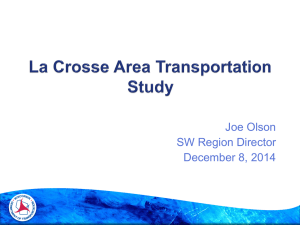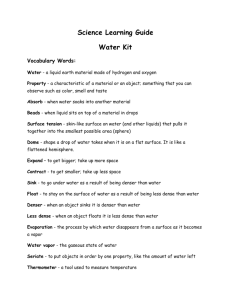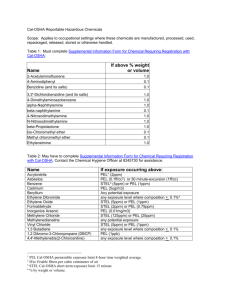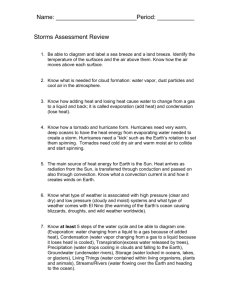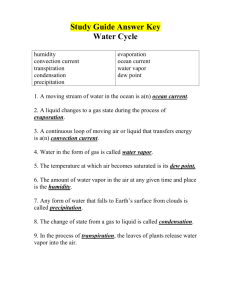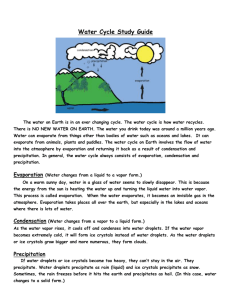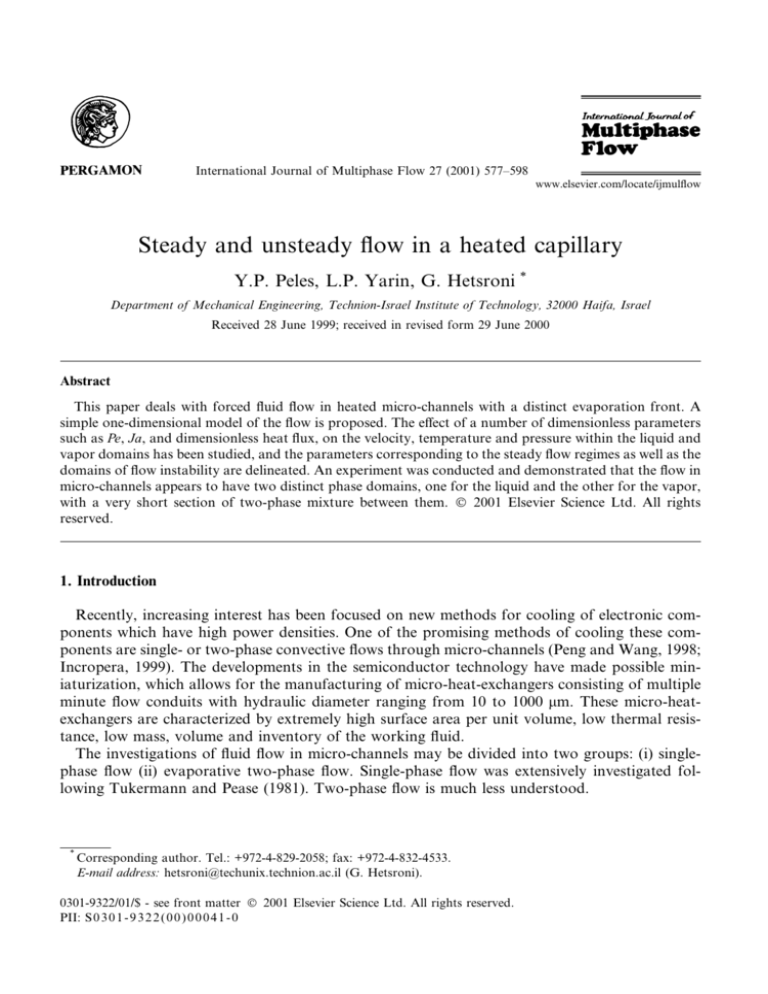
International Journal of Multiphase Flow 27 (2001) 577±598
www.elsevier.com/locate/ijmul¯ow
Steady and unsteady ¯ow in a heated capillary
Y.P. Peles, L.P. Yarin, G. Hetsroni *
Department of Mechanical Engineering, Technion-Israel Institute of Technology, 32000 Haifa, Israel
Received 28 June 1999; received in revised form 29 June 2000
Abstract
This paper deals with forced ¯uid ¯ow in heated micro-channels with a distinct evaporation front. A
simple one-dimensional model of the ¯ow is proposed. The eect of a number of dimensionless parameters
such as Pe, Ja, and dimensionless heat ¯ux, on the velocity, temperature and pressure within the liquid and
vapor domains has been studied, and the parameters corresponding to the steady ¯ow regimes as well as the
domains of ¯ow instability are delineated. An experiment was conducted and demonstrated that the ¯ow in
micro-channels appears to have two distinct phase domains, one for the liquid and the other for the vapor,
with a very short section of two-phase mixture between them. Ó 2001 Elsevier Science Ltd. All rights
reserved.
1. Introduction
Recently, increasing interest has been focused on new methods for cooling of electronic components which have high power densities. One of the promising methods of cooling these components are single- or two-phase convective ¯ows through micro-channels (Peng and Wang, 1998;
Incropera, 1999). The developments in the semiconductor technology have made possible miniaturization, which allows for the manufacturing of micro-heat-exchangers consisting of multiple
minute ¯ow conduits with hydraulic diameter ranging from 10 to 1000 lm. These micro-heatexchangers are characterized by extremely high surface area per unit volume, low thermal resistance, low mass, volume and inventory of the working ¯uid.
The investigations of ¯uid ¯ow in micro-channels may be divided into two groups: (i) singlephase ¯ow (ii) evaporative two-phase ¯ow. Single-phase ¯ow was extensively investigated following Tukermann and Pease (1981). Two-phase ¯ow is much less understood.
*
Corresponding author. Tel.: +972-4-829-2058; fax: +972-4-832-4533.
E-mail address: hetsroni@techunix.technion.ac.il (G. Hetsroni).
0301-9322/01/$ - see front matter Ó 2001 Elsevier Science Ltd. All rights reserved.
PII: S 0 3 0 1 - 9 3 2 2 ( 0 0 ) 0 0 0 4 1 - 0
578
Y.P. Peles et al. / International Journal of Multiphase Flow 27 (2001) 577±598
Hsu (1962) developed a semitheoretical model that provides considerable insight into the eects
of a non-uniform liquid superheat resulting from transient conduction in the liquid during the
bubble growth and release process. The model shows that there is a ®nite range of active cavity
sizes on the heating surface, which depends on subcooling, pressure, heat ¯ux and physical
properties of the ¯ow. For water at atmospheric pressure, temperature dierence between the wall
and saturation temperatures is around 15:6°C, thermal boundary layer thickness of 76 lm near
the nucleation site, and heat ¯ux of 30 W/cm2 , the active nucleation sites are those having cavity
opening of radius 2:5±15 lm. The thermal boundary layer far from the nucleation site was
measured by optical means by Yamagata et al. (1955). It was found that the thickness of the
thermal boundary layer is of the order of 250 lm. Thus the boundary layers of an adjacent heated
micro-channel walls converge in a channel with a hydraulic diameter on the order of 100 lm,
causing a higher bulk temperature and therefore a wider range of active nucleation sites. The
latter results in higher bubble departure frequency. Furthermore, the bubble departure diameter
in channels of regular size is of the order of 1 mm, indicating that the bubble initiation process in
micro-channels is strongly controlled by the surrounding walls.
Peng and Wang (1993) investigated the ¯ow boiling through micro-channels with a cross-section of 0:6 0:7 mm2 . They observed that no partial nucleate boiling existed and that the velocity
and liquid subcooling have no obvious eect on the ¯ow nucleate boiling ¯uid. (Peng and Wang
(1994a,b, 1996)) conducted additional experimental investigations on ¯ow boiling in microchannels with rectangular cross-sections ranging from 0:1 0:3 to 0:6 0:7 mm2 . Peng et al.
(1998) suggested a dimensionless parameter for nucleate boiling in micro-channels, which agree
well with the experimental data.
Bowers and Mudawar (1994) performed an experimental study of pressure drop and critical
heat ¯ux (CHF) in mini-channels with circular cross-section (d 2:54 mm and d 510 lm) using
R-113. A CHF correlation proposed by Katto (1978) was presented as qCHF =GhL;G
0:16We 0:19
L=D 0:54 , where qCHF is the critical heat ¯ux, G the mass velocity, L the channel
length, D the channel hydraulic diameter, hL;G the latent heat of vaporization and We is the
Weber number de®ned as We r=
qL u2 L, where r is the surface tension (N/m), qL the liquid
density (kg/m3 ) and u is the inlet velocity (m/s). As the channel size decreases, the capillary forces
acting in the longitudinal direction become signi®cant. The experiment yields CHF values about
200 W/cm2 . However, the pressure drop for the mini-channels were less than 1 KPa compared to
23 KPa for the micro-channels.
Peles et al. (1998) developed a one-dimensional model for a two-phase laminar ¯ow in a heated
capillary, moved by liquid evaporation at the interface. The approach allows to estimate the eect
of capillary, inertia, frictional and gravity forces on the shape of the interfacial surface as well as
the velocity and temperature distribution. They also demonstrated that at Euler numbers larger
than 108 a self-regulated regime of ¯ow can be realized. A two-dimensional model of steady state
evaporation of liquid±vapor meniscus in a heated capillary slot was considered by Khrustalev and
Faghri (1995).
The aim of the present work is to study the steady, forced ¯ow in a heated micro-channel with a
distinct evaporation front. The calculation is based on a simpli®ed one-dimensional model of ¯ow
with ¯at evaporation front dividing the liquid and vapor into two dierent domains. Speci®cally,
we consider the conditions corresponding to the existence of steady ¯ow with evaporation front.
The knowledge of such conditions is necessary to designing cooling systems of electronic devices
Y.P. Peles et al. / International Journal of Multiphase Flow 27 (2001) 577±598
579
with high power densities, choosing operating parameters ensuring their stability, etc. Our results
are probably restricted to high rates of evaporation in long enough micro-channels.
2. The physical model
Evaporative two-phase ¯ow in a heated micro-channel resembles a two-phase slug ¯ow with
distinct domains of liquid and vapor. These domains are divided by the in®nitely thin evaporating
front, which propagates relatively to the ¯uid with a velocity u0f equal (numerically) the linear rate
of liquid evaporation. In the frame of reference associated with micro-channel walls, the velocity
of the evaporation front is
uf juL j
ju0f j;
1
where uf and u0f are the velocity of the evaporating front in the systems of coordinates associated
with the micro-channel wall and the ¯uid ¯ow, respectively, and uL is the liquid velocity in an
inertial system of coordinate.
Depending on the correlation between u0f and uL , the evaporation front moves downstream
ju0f j < juL j or upstream
ju0f j > juL j (Fig. 1). Essentially, in both cases the ¯ow in the microchannel is unsteady. At the same time, at certain combination of governing parameters (initial
velocity of liquid, heat ¯ux on the wall, etc.) the regime of ¯ow may be steady. It corresponds to
the kinematic condition u0f uL which determines ®xed position of evaporation front in the micro-channel as well as invariable length of the ``liquid'' and ``vapor'' domains. The velocity,
temperature and pressure distributions corresponding to such a ¯ow are plotted in Fig. 2. The
velocity of the vapor increases monotonically along the channel axis, whereas the liquid velocity is
Fig. 1. The scheme of the ¯ow in a heated capillary. uL is the liquid velocity and u0f is the front velocity relative to the
liquid. `L is the liquid length domain and L is the total channel length.
580
Y.P. Peles et al. / International Journal of Multiphase Flow 27 (2001) 577±598
Fig. 2. The velocity, temperature and pressure distributions along the axis of a heated capillary
N u; T ; P ; G and L
correspond to vapor and liquid domains, respectively. Solid line: liquid domain; dotted line: vapor domain (concave
meniscus).
almost constant. The latter is a result of low thermal expansion of the liquid: c 0:18 10 3 K 1
for water at t 20°C (Kuchling, 1980) and qL
TL constant at 20°C < t < 100°C. Accordingly,
within such a range of temperature the change of liquid velocity does not exceed 4%.
At the evaporation front there is a jump in the ¯ow velocity which equals to Du uL
qL;G 1,
where qL;G qL =qG ; qL and qG are the liquid and vapor densities, respectively. Since qL;G 1 a
jump in the ¯ow velocity expresses approximately as Du ' uL qL;G . The temperature distribution
has a characteristic maximum within the liquid domain, which is located in the vicinity of the
evaporation front. Such a maximum results from two opposite factors: (i) heat transfer from the
hot wall to the liquid, and (ii) heat removal due to the liquid evaporation at the evaporation front.
The pressure drops monotonically in both domains and there is a pressure jump at the evaporation front due to the surface tension and phase change eect on the liquid±vapor interface.
Taking into account the above-mentioned factors it is possible to present the stationary ¯ow in
a heated capillary as a ¯ow of liquid and its vapor divided by an in®nitely thin evaporation front.
The parameters of these ¯ows are related to each other by the condition of mass, momentum and
energy conservation at the evaporation front.
To describe the ¯ow in a heated capillary we use the mass, momentum and energy balance
equations. At moderate velocity, the eects due to compressibility of liquid and vapor as well as
energy dissipation in gaseous and liquid phases are negligible. Assuming that thermal conductivity
and viscosity of the vapor and the liquid are independent of temperature and pressure, we arrive
at the following system of equations:
div
qi vi 0;
2
qi vi rhi ki r2 Ti ;
3
qi
vi rvi
rPi li r2 vi ;
4
Y.P. Peles et al. / International Journal of Multiphase Flow 27 (2001) 577±598
581
where q; v; T and h are the density, velocity, temperature and enthalpy (vector v has components
u; v; w which are directed along axis x; y; z, respectively), P the pressure, k and l the thermal
conductivity and viscosity, respectively, r and r2 are the gradient and the Laplace operator;
i G; L corresponds to vapor and liquid.
The system of Eqs. (2)±(4) should be supplemented by relations determining the dependencies
PG
qG TG ; qL
TL and hi
Ti .
At steady ¯ow in a heated micro-channel the conditions at the evaporation front may be expressed by the of continuity of mass, thermal ¯uxes on the interphase surface and the equilibrium
of all acting forces (Landau and Lifshitz, 1959). With reference to the evaporative meniscus the
balance equations have the following form (Peles et al., 1998):
2
X
i1
qi vi ni 0;
2 X
i1
5
oTi
ni 0;
qi vi hi ki
oxi
2
X
2
Pi qi vi vk ni lik
6
or
1
;
lik nk r r1 1 r2 1 ni
oxi
i1
7
where r is the surface tension, lik the tensor of viscous tension; vi ni and
oTi =oxi ni the normal
component of the velocity vector and interphase surface gradient, respectively, r1 and r2 the
general curvature radii of the interphase surface, ni and nk correspond to the normal and tangent
1
2
directions; ni ni ; i 1
G; i 2
L; xi x; y; z.
The radius of curvature r of the meniscus and its depth H express for cylindrical micro-channel as
r r0 = cos h;
8
H r0
1
9
sin h= cos h;
where r0 and h are the radius of the micro-channel and the contact angle, respectively.
When the contact angle is close to p=2 (for example, for the system water/steel h 0:45p) , the
ratio H =r0 is small, we estimate the order of magnitude of the terms in Eqs. (2)±(4) and conditions
(5)±(7). Choosing in the meniscus as characteristic scales of length in the longitudinal and
transversal directions H and r0 , respectively, we obtain
o
1 o
1
;
;
ox H oy r0
o2
1
o2
1
;
:
ox2 H 2 oy 2 r02
10
From Eq. (10):
o2
o2
;
ox2
oy 2
o2 1 o
r 2
y oy
ox
2
11
o
y
oy
o2
:
ox2
12
582
Y.P. Peles et al. / International Journal of Multiphase Flow 27 (2001) 577±598
The components of velocity at the meniscus surface are connected with each other (at qL =qG 1)
by the relation
v=u tan u;
13
where 0 < u < p=2 h; tan u dy =dx ; y
x is the equation which determines the meniscus
shape.
At large contact angle (practically h P 0:4p the following are valid
u > v;
u
o
o
v :
ox
oy
14
Estimates (12) and (14) allow to reduce the problem on ¯ow in a heated micro-channel to solving
the system one-dimensional mass, momentum and energy balance equations. They have the
following form:
dqi ui
0;
dx
qi ui
dui
dx
15
dPi
dx
dFi
;
dx
16
dTi
d2 T i
ki 2 q;
qi ui cpi
dx
dx
17
where q; u; T and P are the density, velocity, temperature and pressure, F the drag force accounting for the eect of viscosity and cp and k are the heat capacity and thermal conductivity,
respectively, q is the heat ¯ux per unit axial length from the wall.
The boundary conditions for the present problem are:
At x 0;
qL qL;0 ; uL uL;0 ; TL TL;0 ;
At x `L ;
At x L;
qi qi;s ; ui ui;s ; Pi Pi;s ; Ti Ts ;
qG qG;00 ; uG uG;00 ;
dTG
0;
dx
18
19
20
where L `G `L is the total length of the micro-channel, `G and `L the length of the vapor and
liquid regions, respectively, subscripts 0 and 00 correspond to the inlet and outlet cross-section,
respectively and s to the evaporation front.
We supplement system (15)±(17) by the equation of state of the vapor and liquid
PG RqG TG ;
21
qL qL
TL
22
by the equation for the vapor pressure at the interphase
Ps Ps
Ts
23
Y.P. Peles et al. / International Journal of Multiphase Flow 27 (2001) 577±598
583
and by the mass and thermal balances at the evaporation front
uG;s uL;s qL;G ;
kL
dTL
dx
24
x`L
kG
dTG
dx
x`L
hL;G qL;s uL;s ;
25
where R is the gas constant.
The momentum balance equation at the evaporation front has (neglecting the eect of viscous
tension and changing surface tension along of meniscus) the following form:
r
cos h qL;s v2L;s
1 qL;s =qG;s ;
26
DP
2r0
where DP PG;s PL;s ; and vL;s is the linear rate of evaporation.
The linear rate of evaporation (cylindrical micro-channel), may be estimated as follows:
vL;s
4q L
;
hL;G qL;s d
27
where q is the heat ¯ux at the wall, hL;G is the latent heat of evaporation.
Using Eqs. (25) and (26) we estimate the contribution of the surface tension in the pressure
jump at the evaporation front, for the following parameters: L=d 102 ; d 2 10 4 m,
qL 103 kg=m3 , qL =qG 103 , hL;G 2:26 106 J=kg; h 80°, r 500 10 4 N=m by calculating the ratio of the ®rst term in RHS of Eq. (25) to the second one at q
3; 30; 300 104 W=m2 . As a result we ®nd that the ratio r cos h=2r0 qL v2L
qL =qG equals 1.39,
0.0139, 0.000139, respectively, for q
3; 30; 300 104 W=m2 It is seen that the pressure jump
in a ¯ow in a micro-channel with evaporation front is determined mainly by the phase change.
The eect of surface tension shows only at small heat ¯uxes at the wall. The latter is typical to any
system ¯uid/wall, in particular, for water/glass system with h 0. In this case the ratio
r cos h=2r0 bqL v2L
qL =qG equals 8.93, 0.0893, 0.000893 for q
3; 30; 300104 W=m2 .
The above-mentioned estimates show that at high power densities, characteristic for cooling
systems of electronic devices, it is possible to neglect the eects due to curvature of the interphase
and present it as a ¯at front.
We add to Eqs. (15)±(17) and (21)±(25) the total mass and energy balances to determine the
vapor velocity and the temperature at the outlet cross-section
qG;00 uG;00 qL;0 uL;0 ;
Q0 qL;0 uL;0 cpL
Ts
28
TL;0 qL;0 uL;0 hL;G qL;0 uL;0 cpG
TG;00
Ts qL;
29
where Q0 kL
dT =dxjx0 is the upstream heat losses from the liquid in the inlet cross-section.
3. Distribution along the micro-channel
Using system (15)±(17) we determine the distribution of velocity, temperature and pressure
within the liquid and vapor domains. We render the equations dimensionless by the following
584
Y.P. Peles et al. / International Journal of Multiphase Flow 27 (2001) 577±598
characteristic scales: uL;0 for velocity, TL;0 for temperature, qL;0 for density, PL;0 for pressure,
qL;0 u2L;0 for the drag force and L for length
ui ui =uL;0 ;
T i Ti =TL;0 ;
P i Pi =PL;0 ;
qi qi =qL;0 ;
x x=L:
F i Fi =qL;0 u2L;0 ;
30
The dimensionless equations take the following form:
dqi ui
0;
dx
dqi u2i
dx
31
dP i
dx
Eu
dF i
;
dx
32
dT i
1 d2 T i
#i ;
Pei dx2
dx
33
where Eu PL;0 =qL;0 u2L;0 is the Euler number, Pei uL;0 L=ai the Peclet number, ai ki =qL;0 cpi the
thermal diusivity, #i qL=qL;0 uL;0 cpi TL;0 is the dimensionless heat ¯ux at the wall.
The boundary conditions for system (31)±(33) are
At x 0;
qL 1; uL 1; T L 1;
At x `L ;
qi qi;s ; ui ui;s ; T i T s ; Pi P i;s ;
At x 1;
qG qG;00 ; uG uG;00 ;
dT G
0:
dx
34
35
36
The additional equations (21) and (23) and conditions (24) and (29) take the following dimensionless form:
P i R qG T G ;
37
Ps P s
T s ;
38
qL qL
T L ;
39
uG;s uL;s qL;G ;
dT L
dT G
kG;L
Ja PeL ;
dx `L
dx `L
40
EuDP We
1
cos h
1
q;
qG;00 uG;00 1;
Q0
T s
1 Ja cpG;L T G;00
41
42
T s #L ;
43
44
Y.P. Peles et al. / International Journal of Multiphase Flow 27 (2001) 577±598
585
where Q0 Q0 =
qL;0 uL;0 cpL TL;0 ; Ja hL;G =cpL TL;0 is the Jacob number,
#L qL=
qL;0 uL;0 cpL TL;0 ;
q qL =qG ;
We
R R
qL;0 TL;0
;
PL;0
cpG;L cpG =cpL ;
kG;L kG =kL ;
2r0 qL v2L
:
r
At large Euler numbers when DP 1 the vapor pressure may be calculated by the Claperon±
Clausius equation. In this case P s and T s in Eq (38) correspond to the saturation parameters.
Integrating (31) and (33) we obtain:
qi ui 1;
45
i
i
T i C1 #i
x Pei 1 C2 exp
Pei x;
i
46
i
where the constants C1 and C2 express as:
L
C2
L
1
C1
1
L
C2
T s
G
Ts
G
C1
C2
#G
#L =PeL ;
47
#L `L =exp
PeL `L 1;
G
C2 exp
PeG `L ;
`L PeG1
48
49
#G =
PeG exp PeG :
50
The temperature distribution has a maximum at
#
"
#
i
:
xm Pei 1 ln
i
Pei C2
i
i
51
i
Such a maximum exists only if C2 < 0 and jC2 j P 1. Since #G and PeG are positive, C2 < 0: It is
L
easy to show that C2 is also less than unity at any values of the operation parameters. Taking
into account expressions (48) and (50) we obtain from (51) the following:
xmL PeL 1 ln
xmG 1:
#L ePeL `L
#L `L
T s
1
;
1PeL
52
53
Thus the maximum of the vapor
xmG and liquid
xmL temperatures are located at the outlet
cross-section of the micro-channel, and in front of the evaporation front (inside of the liquid
domain), respectively.
Consider the pressure distribution in the liquid and vapor domains and taking into account that
the drag force Fi takes the form:
Z x
n
qL;0 u2L;0
mi dx;
54
Fi
2ReL;0
0;`L
586
Y.P. Peles et al. / International Journal of Multiphase Flow 27 (2001) 577±598
we obtain from Eq. (32) the following expressions for the liquid PL and PG pressures:
Z x
n
1
qL 1
mL dx ;
PL 1 Eu
2ReL;0 0
Z x
n
1
P G P G;s Eu
qG;s 1 =qG;s;0
mG dx ;
2ReL;0 `L
55
56
where mi mi =mL;0 ; qL qL;0 =qL ; qG;s qG;s =qG ; qG;s;0 qG;s =qL;0 ; x x=d; d is hydraulic diameter of the micro-channel, n 64 for laminar ¯ow.
Bear in mind that qL is a weak function of the temperature, such that qL is close to unity, we can
write approximate expression of P L
Z x
n
PL '
Eu
mL dx:
57
2ReL;0
0
In accordance with expressions (55) and (56) the pressure drop in the liquid and vapor regions of
¯ow is given by
(
)
Z `L
n
DP L Eu 1
qL;s 1
mL dx ;
58
2ReL;0 0
(
)
Z `G
n
1
qG;s;00 1=qG;s;0
mG dx ;
59
DP G Eu
2ReL;0 `L
where
qL;s qL;0 =qL;s ;
qG;s;00 qG;s =qG;00 ;
DPG P G;s P G;00 :
qG;s;0 qG;s =qL;0 ;
`i `i =d;
DP L 1 P L;s ;
R`
Since 0 L mL dx <
1 mL;s =2`L and vL;s < 1, the following estimate of the maximum pressure
drop in the liquid domain is valid:
n
60
`L :
DP L max '
2ReL;0 Eu
The total pressure drop in a heated micro-channel is
(
!
Z `L
Z `G
n
DP t Eu 1
mL dx
mG dx
qt
2ReL;0
0
`L
)
1
We
1
cos h
;
61
where qt qL;0 =qG;00 .
4. Stationary ¯ow regimes
Rearranging the thermal balance equation (41) and using expressions (46)±(50) we arrive at
(
)
n
o
#L `L
Ts 1
kG;L cpL;G #L 1 e PeL kG;L
1 `L JaPeL ;
62
#L PeL
1 e PeL `L
Y.P. Peles et al. / International Journal of Multiphase Flow 27 (2001) 577±598
587
where
kL;G kL =kG ;
cpL;G cpL =cpG :
The temperature distribution within the liquid and vapor domains of a heated micro-channel is
plotted in Fig. 3. The liquid entering the channel absorbs heat from the walls and its temperature increases. As the liquid ¯ow toward the evaporating front it reaches a maximum
temperature and begins to decrease the temperature while heat transfers to the front from the
liquid in order to establish the evaporation process. An increase of #L leads to shortening of the
liquid domain as well as to a displacement of the point corresponding to the maximum temperature towards the inlet cross-section (Fig. 4). This process is accompanied by a decrease of
the maximum liquid temperature and an increase of the heat losses in the inlet cross-section
(Fig. 5). The eect of PeL on the length of the liquid domain is illustrated in Fig. 6. An increase
of PeL leads to a decrease of `L . The liquid±vapor heat ¯ux ratio at the evaporation front is
shown in Fig. 7. An increase of the Peclet number is accompanied by an increase of
qL =qG x`L .
This is due to the fact that when the vapor±liquid Peclet number increases two events occur: (i)
more heat ¯ux, at the front, is needed to evaporate a larger quantity of liquid, (ii) its in¯uence
on the temperature ®eld, and thus on the temperature slope, diminishes. Since the vapor Peclet
number is very large, compared to the liquid Peclet number, the contribution of the vapor
domain to the front heat ¯ux increases much slower than that of the liquid as the Peclet number
increases, thus
qL =qG x`L must increase.
Eq. (62) contains seven dimensionless parameters accounting for the hydrodynamic and thermal eects. The regimes in which stable ¯ows in a heated capillary are possible correspond to the
following interval of the length `L : 0 < `L < 1. The latter allows us to use Eq. (62) to de®ne the
domains of the existence of stable and unstable ¯ow regimes. In the multi-dimensional parametric
Fig. 3. Temperature distribution in a heated capillary. Solid line: liquid; dotted line: vapor (water at atmospheric
pressure, PeL 6, Ja 1:82).
588
Y.P. Peles et al. / International Journal of Multiphase Flow 27 (2001) 577±598
Fig. 4. The eect of #L on the length of liquid domain `L , for water and atmospheric pressure, Ja 1:82 and PeL 6.
Fig. 5. Dependence of the maximal temperature on #L , for water at atmospheric pressure, Ja 1:82 and PeL 6.
space ( `; #L ; PeL ; Ja; T s ; kL;G ; cpL;G , the limiting values of these parameters correspond to a surface
subdividing the parametric space into domains which correspond to various ¯ow regimes.
The solution of Eq. (62) may be represented as 35 spatial (or 21 planar) diagrams which establish correlations between any three (or two, for the planar diagram) parameters when all the
other parameters are ®xed. These diagrams allow us to outline the domains of stable ¯ow regimes
and to determine the values of the parameters corresponding to the change between the stable and
unstable ¯ows.
Y.P. Peles et al. / International Journal of Multiphase Flow 27 (2001) 577±598
589
Fig. 6. The length of liquid domain as a function of PeL .
Fig. 7. The ratio
qL =qG x`L versus the Peclet number (water at atmospheric pressure).
Consider some particular cases, which are of interest to the understanding of the general ¯ow
properties in a heated capillary. First, we examine a simple case when the Peclet number is much
less than unity. Since `L < 1, the assumption PeL 1 corresponds to the condition PeL `L 1. In
this case Eq. (62) reduces to
2
`L
K1 `L K2 0;
63
where
K1
#L
Ja=#L ;
K2
T s
1=#L PeL :
590
Y.P. Peles et al. / International Journal of Multiphase Flow 27 (2001) 577±598
For any ®nite value of the parameters #L and PeL , it is seen that the dimensionless length of the
liquid domain `L ; cannot be equal to 0 and 1, since the term K2 and the parameter Ja are positive.
To determine a relationship between the parameters corresponding to the stable ¯ow in the case
PeL 1, Eq. (63) should be solved to ®nd `L
q
64
`L 0:5 K1 K12 4K2 :
Since `L should be positive, the physically realistic solution of Eq. (64) is possible only under the
following conditions:
K1 > 0;
65
K12
66
P 4K2 :
From inequality (65) it follows that for
#L > Ja
67
a steady ¯ow is possible.
To estimate the range of possible variations of PeL and #L for a given T s and Ja inequality (66) is
presented in the following form:
PeL P 4
T s
1#L
#L
Ja2
;
68
where the equality corresponds to the low boundary of the stable ¯ow domain.
The dependence PeL PeL
#L is shown in Fig. 8(a). Each point of this curve corresponds to a
certain position of the evaporation front. Extreme points (the upper one `L 0 and the lower one
`L 1 correspond to #L Ja; PeL ! 1 and as #L ! 1 the Peclet number PeL tends to 0, respectively.
The domain of the stable ¯ow is located to the right of the boundary PeL
#L (the shaded region
in the graph). To the left of this curve is the domain in which stable ¯ows in a heated capillary
cannot occur. Relation between the parameters #L and Ja, the parametric plane PeL ±#L may be
subdivided into two domains: (i) #L < Ja, and (ii) #L > Ja. Within the ®rst of these the stable
¯ows cannot occur at any values of the parameters PeL and T s . At #L > Ja various ¯ow regimes
may be realized: (i) a stable ¯ow at PeL > PeLb , and (ii) a unstable at PeL < PeLb (PeLb is the value
of the Peclet number corresponding to the boundary curve).
In the second case when (PeL 1; PeL `L 1), expression (62) reduces to
1
`L
PeL #L fPeL Ja
T s
1 #L
1
kG;L cpL;G g
69
Assuming `L 6 1 in Eq. (69) we obtain
PeL 6
#L
1 kG;L cpL;G
:
#L Ja
T s 1
70
The dependence PeL PeL
#L is shown in Fig. 8(b). The line #L Ja
T s 1 divides the
parametric plane PeL ±#L into two domains: (i) an unstable ¯ow regime domain for any value of
PeL #L < Ja
T s 1, (ii) a stable ¯ow regime domain #L > Ja
T s 1 and
Y.P. Peles et al. / International Journal of Multiphase Flow 27 (2001) 577±598
591
Fig. 8. The dependence PeL
#L . Shaded region: unsteady: (a) PeL 1; (b) PeL 1.
PeL < 1 kG;L cpL;G . Thus, at PeL 1 the domain of stable ¯ows in a heated capillary with a
distinct evaporation front is restricted by the lines #L Ja
T s 1 and PeL 1 kG;L cpL;G .
Note that the last restriction had already been met by the restriction PeL 1.
5. Experimental facility and experimental results.
The experimental set up is shown in Fig. 9. Prior to the experiment, the water was passed
through a 1=2 lm cartridge ®lter, to ®ll up the reservoir. Water was circulated through the ¯ow
loop by a peristaltic pump (6). As the ¯uid leaves the reservoir (10), it passes through a silicon
rubber tube and then ¯ows into the test module (1) and leaves its through the outlet silicon rubber
tube. A special Te¯on cartridge was manufactured to hold the module in place and to move it in
592
Y.P. Peles et al. / International Journal of Multiphase Flow 27 (2001) 577±598
Fig. 9. Experimental set up: (1) test module; (2) heater; (3) electrical contact; (4) micro-channel; (5) Pyrex; (6) peristaltic
pump; (7)±(8) pressure and temperature measurements; (9) cooler; (10) reservoir; (11) IR camera; (12) microscope; (13)
high speed video camera; (14) PC; (15) synchronizer; (16) video recorder.
the x±y plane. The temperature and pressure were measured at both the inlet (7) and exit (8) of the
test section using a 0.3 mm copper±constantane thermocouple and silicon pressure gauges, respectively. The thermocouples and pressure gauge output voltages were recorded by multi-scan
data acquisition module, which in turn was connected to a PC via a data acquisition card. The
input voltage was then translated to °C and kPa by a calibration process prior to the test runs.
A DC power supply with an operating range of 0±60 V was used to supply power to the chip
aluminum resistor (2). The Te¯on module cartridge was placed underneath a high speed CCD
camera (13) mounted on a microscope (12), which photographed the boiling process occurring in
the micro-channel (4) to the PC (14) and a video recorder (16). At the same time an IR (11)
camera measured the resistor's temperature on the other side of the chip. Special software was
used to analyze the IR results and to compute the average and maximum temperature on the chip.
The test module is shown in Fig. 10. The device of micro-channel silicon substrate is shown in
Fig. 11. It consists of some parts: the ®rst and most important is a 525 lm micro-channel silicon
substrate (1) bonded to the 500 lm Pyrex cover (5) and the last is the ¯ow manifold. The microchannel silicon substrate was fabricated by photolithography process on one side and consists of
16 mm long triangular micro-channels (4) having hydraulic diameter ranging from 50 to 200 lm.
On the other side of a 1 1 cm2 aluminum resistor, silicon substrate was evaporated, forming
three distinct channel regions; inlet adiabatic, heat ¯ux dissipation and outlet adiabatic. The
channels side were glued to a Pyrex substrate by anodic bonding to form the chip test module.
While the manifolds were fabricated by plain molding process, the micro-channels substrate
fabrication was quite complicated and was achieved by a multi-stage process. The following main
Y.P. Peles et al. / International Journal of Multiphase Flow 27 (2001) 577±598
593
Fig. 10. The test module.
Fig. 11. The micro-channel silicon substrate bonded to the 500 lm micro-channel cover Pyrex: (1) test module; (2)
heater; (3) electrical contact; (4) micro-channel; (5) Pyrex.
stages were used in the process: (i) double side oxidation of a 525 lm h1 0 0i silicon substrate to
(ii) single side 1200 A
silicon nitride deposition, (iii) silicon nitride channels template
1000 A,
opening by reactive ion etching (RIE), (iv) channels template oxidation buer oxide etching
double side
(BOE), (v) silicon etching by tetramethyl ammonium hydroxide (TMAH), (vi) 4000 A
oxidation, (vii) silicon nitride etching by RIE, (viii) 1000 A oxidation layer etching, (ix) silicon/
Pyrex anodic bonding, (x) aluminum thin ®lm evaporation, (xi) aluminum template etching and
(xii) wafer sawing.
594
Y.P. Peles et al. / International Journal of Multiphase Flow 27 (2001) 577±598
Fig. 12. The (a) triangular micro-channels, (b) unpainted resistor.
Once the micro-channels were fabricated, the manifold were bonded to the substrate to epoxy
glue, and the resistor was wired by silver-based epoxy electric conductor and painted by 1 lm thin
pain to increase the surface emissivity. The triangular micro-channels and the unpainted resistor
are shown in Fig. 12.
Y.P. Peles et al. / International Journal of Multiphase Flow 27 (2001) 577±598
595
The experiments were conducted on a heat exchanger described above, having 17 triangular
micro-channels with hydraulic diameter of 157 lm and mass ¯ow rates of 5.7 ml/min. The applied
heat ¯ux ranged from up to 35 W/cm2 . The deviation of q from its nominal value does not exceed
0.5%. The characteristic value of the dimensionless groups at which the observations were carried
out are: Eu 106 ; PeL 7 102 ; #L 0:3; Ja 1:8. That allows us to study the ¯ow in a
heated capillary outside the domains of the steady ¯ows.
Fig. 13. Flow types in a heated capillary: (a) bubble formation; (b) liquid±vapor front.
596
Y.P. Peles et al. / International Journal of Multiphase Flow 27 (2001) 577±598
The experimental results show that the evaporating mechanism in two-phase ¯ows in microchannels dier considerably from larger sized channels. Two distinct phase domains, one for the
liquid and another for the vapor, were observed, with a very short (in the order of the hydraulic
diameter) section of two-phase mixture between them. This implies that the outlet vapor mass
quality for a steady ¯ow can take only the values of 0 (single-phase liquid ¯ow) or unity (saturated
or superheated vapor). The energy required for the ¯ow with zero outlet quality is much lower
than the energy required for the quality larger than one. Thus an energy gap is found between
those energy levels, for which steady evaporating two-phase ¯ow does not exist. If the applied heat
¯ux is sucient to initiate evaporation at quality lower than one an unsteady ¯ow is expected with
an outlet phase ¯ow ¯uctuation corresponding to some time-average mass quality lower than one,
as was shown to be the case in the present experiment. This agrees well with the theoretical model
results since it lies in the unsteady ¯ow region (#L < Ja
T s 1) as can be seen in Fig. 8(b).
The development of the two-phase ¯ow in a heated capillary at dierent Peclet number is illustrated in Fig. 13. It shows that dierent mechanisms of two-phase ¯ow formation may occur
depending on the value of PeL . At small PeL the ®ne bubbles formation (on the micro-channel
wall) plays a dominant role. Growth of these bubble leads to a blockage of the micro-channel, to a
sharp change of the hydraulic resistance and ultimately to an unsteady gas±liquid ¯ow. This eect
is negligible at large Peclet number. In this case liquid evaporation is accompanied by formation
Fig. 14. Unsteady ¯ow in a heated capillary: #L 0:3; Ja 1:83; PeL 598.
Y.P. Peles et al. / International Journal of Multiphase Flow 27 (2001) 577±598
597
of the two-phase ¯ow with distinct vapor±liquid evaporation front dividing the domains of the
liquid and the vapor. Depending on the values of the governing parameters such ¯ow may be
steady or unsteady. A particular ¯ow at PeL 500 and #L 0:3 (the conditions correspond to
boundary of the unsteady ¯ow domains) are shown in Fig. 14. A number of successive photos of
the ¯ow are presented. They show that the position of the evaporation front changes during
the periodical observation. Thus at the given values of parameters the ¯ow in a heated capillary
is non-steady. The latter agrees with the estimation of the boundary of steady states given in
Section 4.
6. Conclusion
In the present paper a simpli®ed one-dimensional approach to study two-phase ¯ow in a heated
micro-channel was developed. This approach was used to study the steady ¯ow regimes as well as
to determine the boundary of the steady ¯ow domains. The eect of a number of dimensionless
parameters (Pe; Ja; #, etc.) on velocity, temperature and pressure distributions within the domains
of liquid or vapor has been studied. The experimental investigation of the ¯ow in a heated capillary was carried out. It has been shown that, depending on the value of the Peclet number,
various types of the process occurred. At small PeL , the dominant role is the bubble formation at
the channel wall, whereas for PeL 1, liquid evaporation leads to formation of an evaporation
front.
The experimental results also demonstrated that evaporating two-phase ¯ow in micro-channels
with time-average mass quality lower than one is unsteady. This result agrees well with the onedimensional model prediction. Physically this ¯ow regime can be explained by the special
mechanism associated with the micro-channel geometry, which appear to have two distinct phase
domains: one for the liquid and the other for the vapor, with a very short section of two-phase
mixture between them. It follows that the outlet ¯ow can exhibit only single-phase, either liquid or
vapor. Thus, a vapor mass quality lower than 1 means alternating outlet phase with a time-average quality lower than one.
Acknowledgements
This work was supported by the Ministry of Science and the Arts (State of Israel). L.P. Yarin is
supported by the Israel Council for Higher Education.
References
Bowers, M.B., Mudawar, I., 1994. High ¯ux boiling in low ¯ow rate, low pressure drop mini-channel and microchannel heat sink. Int. J. Heat Mass Transfer 37, 321±332.
Hsu, Y.Y., 1962. On the size range of active nucleating cavities on a heating surface. J. Heat Transfer 184, 207±213.
Incropera, F.P., 1999. Liquid Cooling of Electronic Devices by Single-phase Convection. Wiley, New York.
Katto, Y., 1978. A generalized correlation for critical heat ¯ux for the forced convection boiling in vertical uniformly
heated round tubes. Int. J. Heat Mass Transfer 21, 1527±1542.
598
Y.P. Peles et al. / International Journal of Multiphase Flow 27 (2001) 577±598
Khrustalev, D., Faghri, 1995. Fluid ¯ow eect in evaporation from liquid±vapor meniscus. J. Heat Transfer 118, 725±
730.
Kuchling, H., 1980. Nachschlageb
ucher f
ur Grundlagenf
acher, Physik. Verb. Fachbuchverlag, Leipzig.
Landau, L.D., Lifshitz, E.M., 1959. Fluid Mechanics. Second ed., Pergamon, London.
Peles, Y.P., Yarin, L.P., Hetsroni, G. 1998, Heat transfer of two phase ¯ow in a heated capillary, Heat transfer 1998. In:
Proceedings of the 11th International Heat Transfer Conference Vol. 2, Kyongju, Korea, p. 193±198.
Peng, X.F., Wang, B.X., 1993. Forced convection and ¯ow boiling heat transfer for liquid ¯owing through microchannels. Int. J. Heat Mass Transfer 36, 3421±3427.
Peng, X.F., Wang, B.X., 1998. Forced convection and boiling characteristics in microchannels. 1998, Heat Transfer
1998. In: Proceedings of the 11th IHTC, Vol. 1, p. 371±390.
Peng, X.F., Wang, B.X., 1994a. Cooling characteristics with micro-channeled structures. J. Enhanced Heat Transfer 1,
315±326.
Peng, X.F., Wang, B.X., Peterson, G.P., Ma, H.B., 1994b. Experimental investigation of heat transfer in ¯at plates with
rectangular micro-channels. Int. J. Heat Mass Transfer 37, 127±137.
Peng, X.F., Peterson, G.P., Wang, B.X., 1996. Flow boiling in binary mixtures in micro-channels plates. Int. J. Heat
Mass Transfer 39, 1257±1263.
Peng, X.F., Hu, H.Y., Wang, B.X., 1998. Boiling nucleation during liquid ¯ow in micro-channels. Int. J. Heat Mass
Transfer 41, 101±106.
Tukermann, D.B., Pease, R.F.W., 1981. High performance heat sink for VLSI. IEEE Electron Device Lett. EDI 2, 126±
129.
Yamagata, Hironai, F., Mishikawa, K., Matsouka, H., 1955. Nucleate boiling of water on the horizontal heating
surface. Memoirs of the Faculty of Engineering, Vol. 15, p. 98, Kyushu University, Japan.

